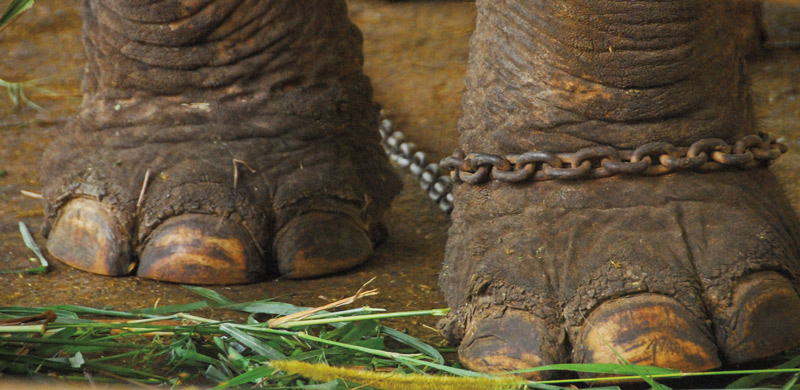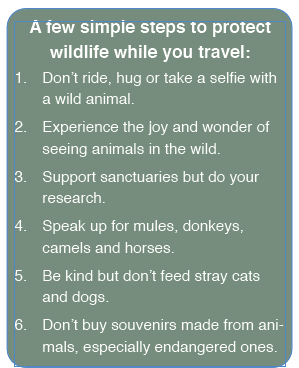
By Beth Sharpe, Toronto, Canada
Beth is the Communications Director for World Animal Protection Canada. An avid traveller, she is always looking for animal-friendly ways to see wildlife. Top trips include whale watching on two of Canada’s coasts, snorkeling in Tahiti, Belize and the Caribbean, supporting a dog vaccination clinic in the Philippines, and bird watching in Costa Rica.
Seeing animals when you travel can be an amazing experience. Feeling the salt spray in your face as your whale watching boat takes off towards a spout of water on the horizon, or spotting through the pre-dawn light the many iconic animals of Africa while on safari are “bucket list” adventures for many of us.
Responsibly managed tours can give you a great experience, provide income to local tour operators and protect wildlife – the trick is figuring out which tours are good and which are not.
Unfortunately, many wild animals are taken from their natural environments to be exploited for entertainment and profit. When you travel, you may see animals that belong in the wild being used in live shows or being offered up for rides. You may be approached to pose with animals for photos, or be offered animal souvenirs. Often, the worst cruelty is hidden from view.
Top tips from World Animal Protection to keep you safe and protect animals when you travel
Sadly, many tourists who love animals may contribute to animal suffering simply because they’re unaware of the hidden cruelty. World Animal Protection helps people, like you, protect animals. Being animal friendly when you travel means you always show respect – for the people, the culture, the environment and the animals, in every country you visit. It only takes a few simple steps to protect wildlife while you travel:
1) Don’t ride, hug or take a selfie with a wild animal. To make elephants submit to people riding and interacting with them, they are taken from their mothers when babies and forced through a horrific training process known as ‘the crush’. It involves physical restraints, inflicting severe pain and withholding food and water. By the time tourists come to ride an elephant, it may look at peace, but this is because it’s spirit has been broken.
Tiger cubs are separated from their mothers at an early age so they can be used as photo props. They are handled and hugged by tourists and typically kept chained up, or in small barren cages.
Lion cubs are bred and taken from their mothers typically within a month of birth to supply the growing lion tourism industry, mostly located in Southern Africa. Tourists handle the cubs for hours and pose with them for photos. They are also often told to hit the cubs if they display aggressive or unwelcome behaviour.
When the cubs grow too big for tourists to pick up and hug – but are still young enough to control – they are used for the relatively new “walking with lions” tourist experience. The lions are trained to ‘safely’ walk with tourists, sometimes on leads. These lions face a lifetime in captivity as they cannot be released into the wild.
2) Experience the joy and wonder of seeing animals in the wild. It’s as simple as that. Choose animal encounters that don’t exploit wild animals. Investigate your options. There are many travel companies that specialize in these types of tours. Visit worldanimalprotection.ca for more.
3) Support sanctuaries but do your research. Any facility can call itself a “sanctuary”, but that doesn’t mean it is. Here are some tips to tell the good ones from the ones you should avoid. Check their websites and ask these simple questions:
Where did the animals come from? A good sanctuary doesn’t take animals from the wild unless they are injured and cannot survive on their own. Good sanctuaries also don’t breed animals for a life in captivity or sell animals (or their parts).
What is its purpose? A good sanctuary doesn’t use wild animals for entertainment, where animals are forced to give rides, do shows, or perform tricks.
Does the facility release rehabilitated animals into the wild? Some sanctuaries may release rescued and rehabilitated animals as part of an official and properly managed program. These types should restrict public viewing as this can habituate animals to people and threaten the success of the animal’s reintroduction to the wild.
Are they accredited? A good sanctuary must comply with strong animal welfare standards to ensure the physical and psychological welfare of all animals under its care. We recommend the standards developed by the Global Federation of Animal Sanctuaries.
How close can you get? A good sanctuary conducts public tours carefully to minimize the impact on the animals, does not cause them stress, and gives animals the ability to seek undisturbed quiet privacy areas.

4) Speak up for mules, donkeys, camels, horses and all animals. Some trips and treks will use working animals to carry loads or people. Working animals must be treated with consideration and must be given adequate shelter, care, food and water. Watch out for these animals being overworked, overloaded or forced to work through ill-treatment and speak up to your guide, the tour operators, travel companies and your hotel concierge. There are also many local animal protection groups that may be able to help you.
It’s also important to recognize people who put the well-being of their animals as a priority. If you see well-looked-after donkeys and horses, a compliment can have just as much positive impact as a complaint. Let the tour operators know that you are choosing to be their customer because of their animal welfare policy and how well their service providers are treating their animals.
5) Be kind but don’t feed stray cats and dogs. In almost every part of the world, humans keep dogs and cats. In many countries like Canada, there is consistent vet care and licensed ownership. However, dog and cat ownership can vary in different countries. Dogs and cats that you encounter on vacation may be genuine strays, or they may be free-roaming animals that are community-owned and fed. Rather than just offering them scraps, which could take them away from a more dependable longer-term food source, see if there is a local animal protection group working on a sustainable solution that you can support.
Dogs and cats can transmit zoonotic diseases, such as rabies, so, for your own safety, take great care during any encounters, and seek immediate medical advice if you are bitten or scratched by an animal with an unknown medical background.
6) Don’t buy souvenirs made from animals, especially endangered ones. You may have the opportunity to buy food, traditional medicine and souvenirs made from animals. When deciding on a souvenir to bring home to remind you of your latest adventure, choose an item that doesn’t endanger the survival of an animal species.

Visit us at:
worldanimalprotection.ca


